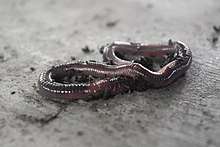Eudrilus eugeniae
Eudrilus eugeniae, also called the "African Nightcrawler", is an earthworm species native to tropical west Africa and now widespread in warm regions under vermicompost; it is an excellent source of protein and has great pharmaceutical potential.[1][2]
| Eudrilus eugeniae | |
|---|---|
 | |
| Scientific classification | |
| Kingdom: | |
| Phylum: | |
| Class: | |
| Subclass: | |
| Order: | |
| Family: | |
| Genus: | Eudrilus |
| Species: | E. eugeniae |
| Binomial name | |
| Eudrilus eugeniae Kinberg, 1867 | |
Growth
Fecundity, growth, maturation and biomass production were all significantly greater at 25 °C than 15°, 20°or 30°. {25 °C = 77 °F}
The growth of individual earthworms increased the lower the population density, but the greatest overall earthworm biomass production occurs at the highest population density.
The greatest number of cocoons per week and the number of hatchlings per cocoon are obtained at 25 °C. Cocoons of E. eugeniae hatched in only 12 days at 25 °C, and the worms reach sexual maturity in as little as 35 days after hatching.
Etymology
Named after Johan Gustaf Hjalmar Kinberg's Swedish survey ship, the ‘Eugenie’.
Life cycle
Throughout its life cycle, E. eugeniae grows much more rapidly than Eisenia fetida, in similar environmental conditions. The African Nightcrawler grows well at a temperature of 24-30 °C (75-86 °F). Maximum weight of around 2.5 grams occurs within 8–10 weeks.
The African Nightcrawler has a uniform purple-grey sheen and the posterior segments are evenly tapered to a point. The segments of the Brandling worm (Eisenia fetida) alternate reddish-orange and brown; the posterior segments do not taper, and the final segment is blunt.
References
- Blakemore, R.J. (2015). "Eco-taxonomic profile of the iconic vermicomposter - the 'African Nightcrawler', Eudrilus eugeniae (Kinberg, 1867)". African Invertebrates 56: 527-548. Archived from the original on 2016-10-22.
- Blakemore, Robert J. (2015). "Eco-Taxonomic Profile of an Iconic Vermicomposter — the 'African Nightcrawler' Earthworm,Eudrilus eugeniae(Kinberg, 1867)". African Invertebrates. 56 (3): 527–548. doi:10.5733/afin.056.0302.